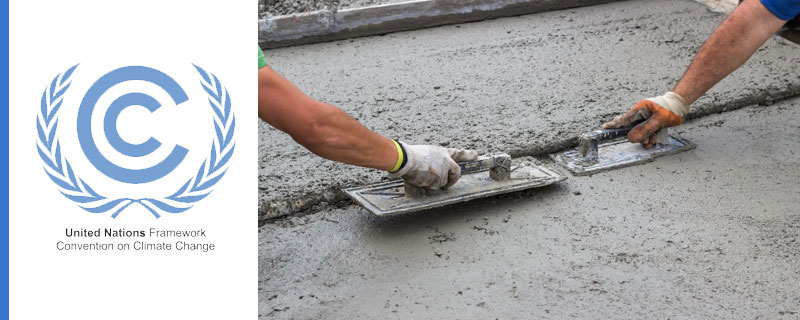Cutting Concrete Emmissions: New Progress Report Launched at COP29
- New report highlights decarbonisation action and progress of global cement industry and the required government policies to accelerate net zero progress.
- Formal call for action from the cement and concrete industry to policymakers around the world to increase their support.
- Case studies from across the world highlight development of carbon capture, increasing use of alternative energy sources and use of new materials and technology.
- GCCA’s Cement Industry Net Zero Progress Report 2024/25 on its Concrete Future 2050 Roadmap for Net Zero Concrete launched three years ago.
The extensive decarbonisation work being carried out by the global cement and concrete industry to cut CO2 emissions is set out in a newly published progress report, launched at COP29 in Baku, Azerbaijan.
The launch of the report includes a formal call to action from the Global Cement and Concrete Association (GCCA) and its members for governments and policymakers around the world to help the sector achieve its key decarbonisation goals through implementing key enabling policies.
Fernando González, President of the GCCA and CEO of Cemex said:
“Our industry is engaged in the most significant transformation in its history as we address the most pressing challenge our planet faces – climate change.
“However, to fully unlock our decarbonisation progress in this crucial decade to deliver, we urgently need effective policy support. When policymakers provide the right market conditions and policy enablers, significant CO2 reductions are achievable faster.”
The report calls for the urgent implementation of effective policies which promote the use of municipal and industrial waste as sustainable alternative fuels for cement kilns, as well as using construction demolition waste as recycled raw materials. Other key policies include a change in building codes to encourage the wider adoption of blended cement and concrete products, as well as the establishment of market-driven national carbon pricing mechanisms that incentivise decarbonisation and investment in clean innovation.
Thomas Guillot, Chief Executive of the GCCA said:
“This report shows several great examples of action that is already happening on the ground across the world, demonstrating that an acceleration of our decarbonisation efforts is taking place today where enabling policies exist.
That’s why it’s important that we are in Baku at COP29, calling on all policymakers, governments and anyone with a stake in the built environment to urgently work with us on our net zero mission.”
Three years on from the launch of its net zero roadmap, the GCCA’s Cement Industry Net Zero Progress Report 2024/25 highlights the leading role that the companies across the world are playing in the decarbonisation of this essential global industry.
Among the decarbonisation projects which GCCA member companies are working on, and are featured in the report, are:
Acceleration of Capture Utilisation and Storage (CCUS) which accounts for 36% of the industry’s planned CO2 reductions, according to the GCCA Roadmap. CCUS has taken a big leap forward with, for example, the scheduled mechanical completion at the end of 2024 of the world’s first industrial sized carbon capture cement plant at Brevik, Norway, run by Heidelberg Materials, which will produce net-zero cement at scale by capturing the CO2 at source and storing it safely underground.
Other CCUS plants featured in the report include Buzzi in Germany, CNBM in China, Holcim across Europe, Taiheiyo Cement in Japan, and TITAN Cement in Greece. Publicly announced projects are collated and made available to see on the GCCA/LeadIT green cement technology tracker.
The increasing use of alternative energy sources. Examples include more use of solar power in Ireland by Breedon, Bulgaria by TITAN Cement and in India by UltraTech Cement.
Projects making use of non-recyclable and industrial waste as fuel for cement plants. These initiatives help effectively manage societal waste and support a circular economy. Examples come from Cemex, in partnership with the municipality of Queretaro, Mexico delivering the country’s first zero waste-to-landfill initiative; Huaxin in China; JSW Cement in India.
The development of technology and alternative materials to make low carbon cement. These projects use less clinker – the carbon intensive element of traditional cement production, and make more use of alternative materials, such as calcined clay. Examples include a new low-carbon cement, ECO3, by CRH containing calcined clay and has been used in major construction projects including the landmark 85-metre-high Tilia Tower, near Lausanne, Switzerland; Cementos Argos’s Rioclaro plant in Colombia; in Taiwan, Asia Cement Corporation is now supplying more low clinker cements.
Lower carbon Concrete and circularity, and design and construction. In the USA, the NRMCA 2024 Concrete Innovations Awards went to 10 projects that used innovative product to lower the project’s embodied carbon; Heidelberg Materials supplied 333 tonnes of 3D concrete printing material for the largest 3D printed building in Europe; Molins will recycle 100,000 tons of demolition material from the old Camp Nou, Spain which will be given a second life as raw materials for concrete for the new football stadium for FC Barcelona; Votorantim Cimentos’ Spectra product has been used on a 36-storey project in Brazil to optimise concrete and steel use as well as reduce water and carbon emissions.
Source: World Cement








Leave a Reply
Want to join the discussion?Feel free to contribute!